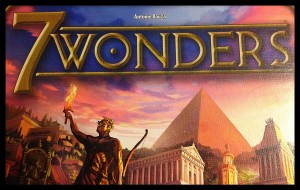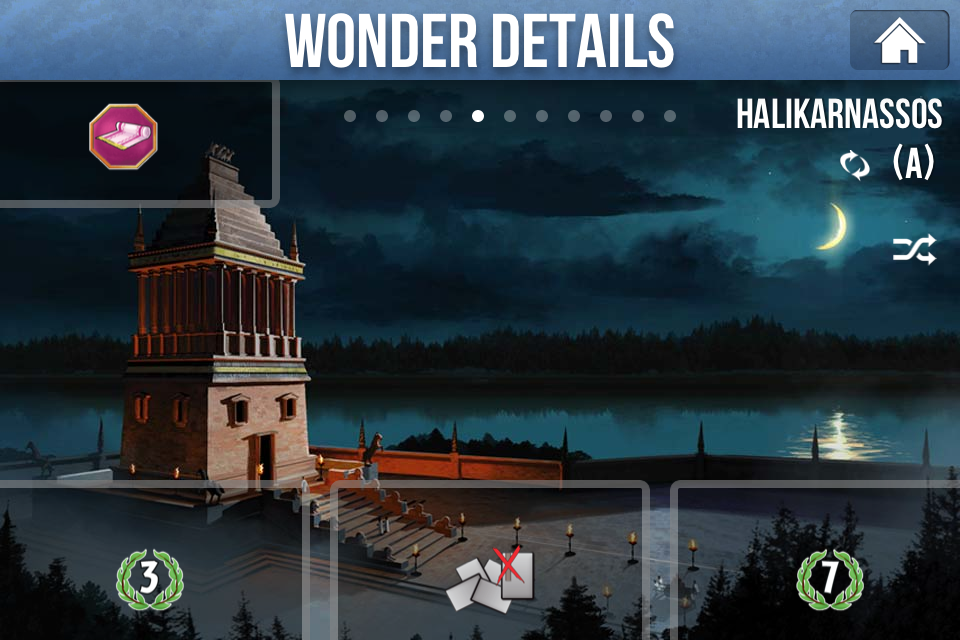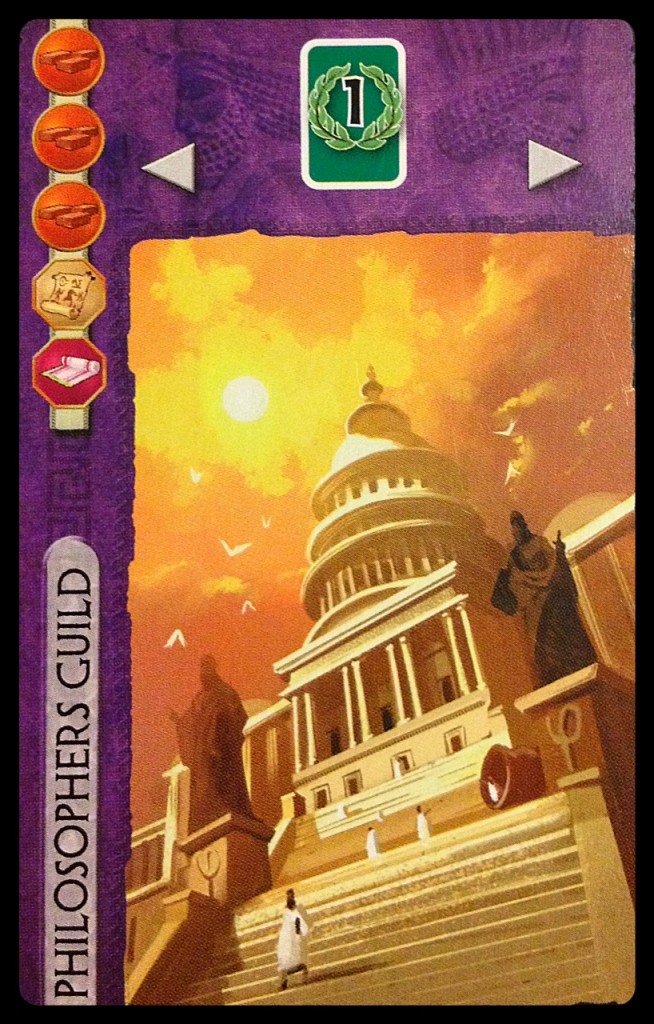I’ve been wracking my brains for a few weeks on how to present this.
‘This’ being a discussion or analysis of tabletop games, a topic that, once upon a time, didn’t require the adjective in front of ‘games.’ But with the advent of video games, and the blurring of lines between sports and gaming (whether referring to betting, fantasy sports, or poker & darts on ESPN), I’ve felt that the grand tradition of tabletop games has become the long-lost brother of Western pop culture and entertainment.
And this led me to an idea: if we can break down & analyze movies, books, and music, why not do the same with games? Sure, I can go to Boardgamegeek.com and find such writing, but why can’t we also bring it to a more general audience? Hence the experiment that is my new series for the Recorder, “Games on Addison.”
The goal of this series is to explore and analyze tabletop games in the same manner as other forms of popular entertainment — film, music, video games, books, and the like. It is not meant to be a ‘review’ of these games, but a means of bringing attention to and discussion of games in a popular culture forum (that is, the Recorder).
This idea has been percolating in my brain for years, though the advent of the Geek & Sundry web channel (and its gaming series, Tabletop) brought it back to the forefront. Thus, for the first entry in this series, I’ll hearken back to a game I briefly mentioned when I wrote about Tabletop and digital media: 7 Wonders.
7 Wonders is a recent and award-winning game from Repos Productions, wherein each player is takes the role of one the civilizations that built the Seven Wonders of the Ancient World (hence the name). It’s a game that rewards resource management and adaptability, and once the players get the hang of the mechanics, it plays exceedingly quick.
Let’s get to know 7 Wonders.
Concept
As mentioned above, each player takes the role of a city in antiquity. The goal of each city is, by the end of the game, to become the most awesome of civilizations. Awesomeness is measured by Victory Points; if you have more points at the end of the game than any other city (player), you are the pinnacle of ancient civilization (and thus win the game).
Gameplay
7 Wonders is a variation on a card-drafting game, and lasts for three Ages (rounds). At the start of each Age, every player is dealt a hand of seven cards. An Age is made up of six turns, after which neighboring cities compare Military strength. A turn consists of each player looking at their hand, playing a single card, and then passing the rest of the hand to their neighbor. All players take their turns simultaneously.
“Playing a card” means one of three things:
- If you can afford the cost (in resources or coins) of the card, you can “build” it as a structure in your city. Simply place it face-up in front of you.
- If you can’t afford the card’s cost, or just don’t want your opponent to have it, you can discard it. It’s discarded, face-down in a common pile, and you earn three coins for it.
- Or, if you can afford the cost, you can use the card to build the next stage of the Wonder associated with your city. You place it face-down under your city, under the stage of the Wonder you’ve just built (more on Wonders below).
Once players understand the gameplay, a typical game might last 30 minutes or less. This makes it ideal for either a pick-up game when players don’t have much time, or as a short diversion before or after a longer game. Because of the random elements and the multiple roles available (each city has two versions, meaning 14 possible roles for players), 7 Wonders also functions well as a longer game, by playing a set of three or four individual games in a row.
Players
A standard game of 7 Wonders requires 3-7 players, and is as balanced & fun with three players as it is with seven. This is because the card decks for each Age change in composition, depending on the number of players.
The basic game also includes a variant for 2 players, and the upcoming Cities expansion includes rules for an 8-player variant and team play.
Mechanics & Themes
The primary themes in 7 Wonders are resource management & adaptability. During most turns, you won’t know what will be in the cards that your neighbor hands you. Being flexible in your strategy will enable you to minimize the likelihood that someone will pass you a hand of ‘useless’ cards. Solid management of your resources feeds this flexibility, and can also keep your city on the leading edge of awesomeness (that is, Victory Points).
But another important theme in 7 Wonders is that of neighbors. Part of resource management is being able to buy resources of your neighbors (or tempting them with your resources, for which they will give you shiny coins). In addition, you will be competing directly with your neighbors in terms of Military strength. And when you play a card from your hand, you are effectively denying your neighbor the use of that card. Thus, while you are solely responsible for building up your city & civilization, you cannot win the game if you don’t pay attention and interact with your neighbors.
Components & Strategy
So far, we’ve covered the general concepts of the game. Now we get specific, looking at the various types of cards and strategies that go with them as you’re playing 7 Wonders. As with most tabletop games (and for that matter, with films, books, or most other forms of pop culture), these specific discussions have more meaning after you’ve played a game or two.
Wonders – The Wonder is at the core of this game. There are no cards for your city’s Wonder; the costs and effects are printed directly onto your city’s game board. Each Wonder consists of between 2-4 stages in a specific order — you have to build the first stage before you build the second stage, and so on. You do not have to build your Wonder, and it’s possible to win without building all your Wonder’s stages.
That said, you should usually factor your Wonder into your overall strategy. This is not only because Wonders give you Victory Points, but because each city’s Wonder also provides a unique advantage for its player.
The Temple of Artemis at Ephesus gives you a financial advantage, while the Colossus of Rhodes provides a leg up on military strength. The Lighthouse of Alexandria gives you more resources; the Pyramids at Giza provide the opportunity for significantly more Victory Points than any other Wonder. Using the benefits of your city’s Wonder can mean the difference between winning and losing.
Coins – Wealth can be its own reward and symbol of status, which is why your wealth counts as Victory Points at game’s end. This, however, is not the best use of your coins. You will get far more value out of your coins when you use them to acquire resources, which you can then turn into cards that are worth far more Victory Points.
Resources (brown / grey cards) – Since this is a game where you build civilizations, you’ll need the raw materials to do so. The most direct way to get these materials is to build Resource structures like Quarry Pits and Looms. But since Resource cards by themselves aren’t worth victory points, there’s no real reward for having the most.
Resource strategy is central to 7 Wonders – too few, and your final Age will be nothing but frustration; too many, and you’ll be behind everyone else in building the structures that matter (i.e., the ones that give you Victory Points). The best strategy is to pay attention to the resources your neighbors have available, since you’re able to buy them. If you’ve got at least one of each resource (and enough to build your Wonder) in front of or next to you, you’ll be in a good spot come the final Age.
And to help with your resource strategies are…
Commercial structures (yellow cards) – Commercial structures are the pins that can hold together your civilization, even though they’re not a direct route to victory. They aren’t Resource cards, but they can assist you in procuring resources. They’re not coins, but they can help you gain (and keep) some of that filthy lucre. They aren’t always worth victory points, but they can be enough to put you on top of the heap.
Commercial structures built in either Age I or II can also start a “chain.” A chain simply means that a structure you built in a previous Age allows you to build a related structure in the current Age for free.
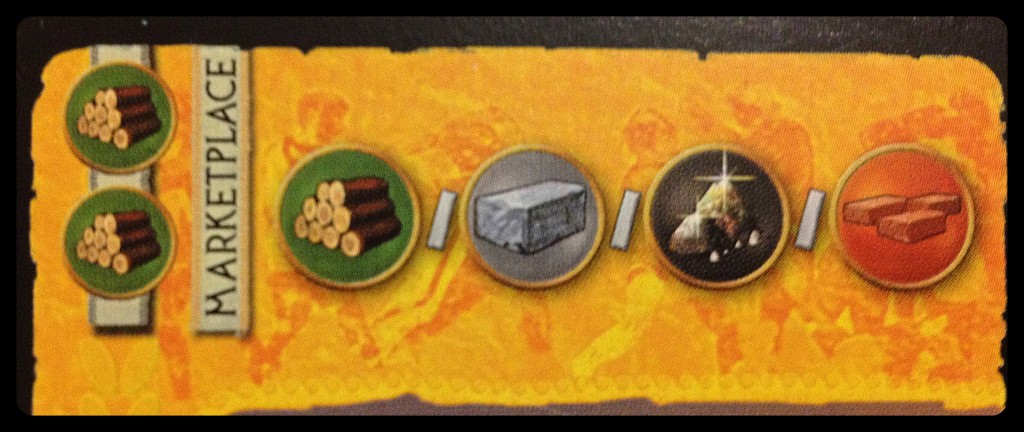
For example, if you wanted to build this Caravansary, you would either need 2 Wood resources, or have already built a Marketplace.
(Yes. “Caravansary.” I didn’t know what one was, either, until this game.)
An even better type of card for chains are the…
Scientific structures (green cards) – Scientific cards are one of the main methods to directly accumulate Victory Points (the others being Military cards, Civilian cards, and Wonders). When it comes to points, green cards tend to be exponential. That is, a couple Scientific structures will only get you a couple of points. If you build more than a few structures, however, the points quickly start to jump higher and higher. In theory, you can score more points with green cards than you can any other color — if your opponent lets you.
But Scientific cards serve more than one purpose in 7 Wonders. They also form more chains than any other type of card, allowing you to build Military, Civilian, and other Scientific structures in later Ages. That Workshop you built in Age I can lead to free Military & Science structures; that Scriptorium in front of you can chain together with Civilian & Scientific structures.
Even if you don’t focus on getting those exponential points, the ability to nab a few Victory Points while setting yourself for chains later on is a useful one. This is in contrast to the more straightforward strategy of the…
Civilian structures (blue cards) – Civilian structures are rather simple: you build one, it gives you Victory Points. That’s it. No calculating, no comparing. Build the structure, get the points. A few blue cards will chain together for more blue cards, but their main purpose is to directly give you points.
Civilian structures are the easiest category to focus on. The difficulty is that it’s easy for anybody to play a blue card, if they have the resources. And if you’ve been focused on primarily one color all game, a savvy opponent can deny you that color in Age III — meaning you’ll find yourself spinning your wheels while everyone else pulls ahead.
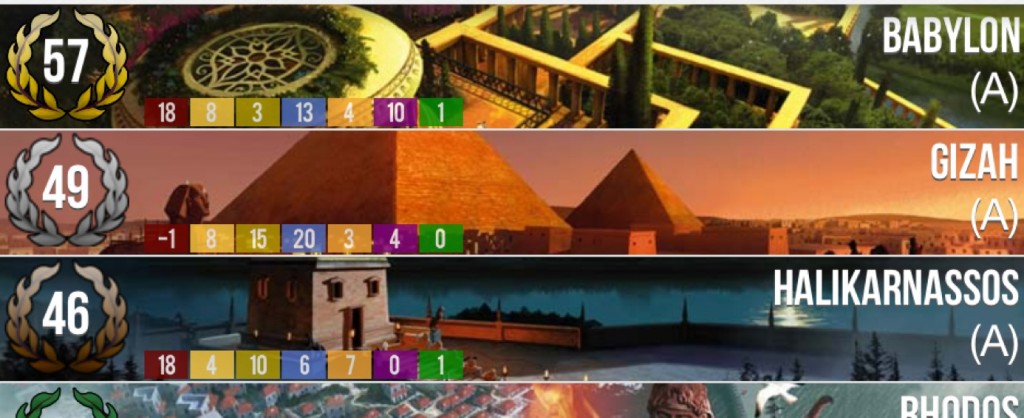
Even with all those Victory Points from Civilian structures & its Wonder, Gizah still could not overcome the balanced awesomeness of Babylon.
Then again, if your opponents are going to keep giving you these points, you might as well take them (when convenient). A similar thing goes for…
Military structures (red cards) – This is the final color that can net you big points. Where Science is exponential, and Civilians are straightforward, the Military is competitive. In other words, you earn (or lose) Victory Points when your Military strength is combined against your neighbors’ strength. If, at the end of each Age, you have more strength, you gain points; if you have less, you lose a point. The later the Age, the more points you earn.
Focusing on Military structures can be a dicey strategy. Of the primary methods of earning points, red cards are the most limited (you can only get two Military victories each Age, for three Ages). And if you’re playing a larger game, focusing on Military structures might cause an arms race amongst you & your neighbors — which will likely benefit the peaceful players on the other side of the table.
On the other hand, this is the only color where players can lose Victory Points. If you stay balanced in your approach to the other colors, and a step ahead of your neighbors in the red cards, you can hold them back while you strive forward.
You may have noticed that I’ve repeated the mantra of balance, of a diversified portfolio of colors and structures. One reason is that it allows flexibility and adaptability; another reason is what comes into play during Age III…
Guilds (purple cards) – Exclusive to the final Age, the Guilds exist solely to get you more Victory Points. But the purple cards are expensive, and don’t give you points themselves — they give you points based upon other cards on the table (usually those found in your neighbors’ cities). For example, the Philosophers Guild gives you a Victory Point for every Scientific structure your neighbors have built. If one or both of them have been too focused on green cards, this one purple card will negate a lot of their points advantage.
The difficulty with Guilds (other than their high resource cost) is their randomness. There are ten Guilds in 7 Wonders, but only some of them are shuffled into the Age III deck of cards. This means that if you plan on ignoring Science, and making it up by playing the aforementioned Philosophers Guild… you better hope that said card made its way into the deck.
Expansions
This analysis has looked at the core board game of 7 Wonders. Like many contemporary tabletop games, however, there are expansion sets that add new layers to the core game. In the case of 7 Wonders, there are two expansions so far, titled Leaders and Cities. Both sets add new Guilds and new Wonders to the mix; each also adds a new color of card: Leader (white) cards, and City (black) structures. The new colors add new mechanics and strategies, which would make an interesting topic for a follow-up in the “Games on Addison” series.
—
For future installments of this series, I plan on looking at tabletop games old and new, such as the classic Call of Cthulhu role-playing game or the recent party game for horrible people, Cards Against Humanity. I’m going to consciously avoid games that are featured on Tabletop for the moment, as the Geek & Sundry folk have a wee bit more of an audience than the Recorder does, and as they’re achieving a similar end – to bring tabletop games back into the popular vernacular.
A discussion which, if I can help it, will also make sure everyone gets all those old-timey card game jokes from the Marx Brothers’ movies.
http://youtu.be/8CQHOCsOfWw

